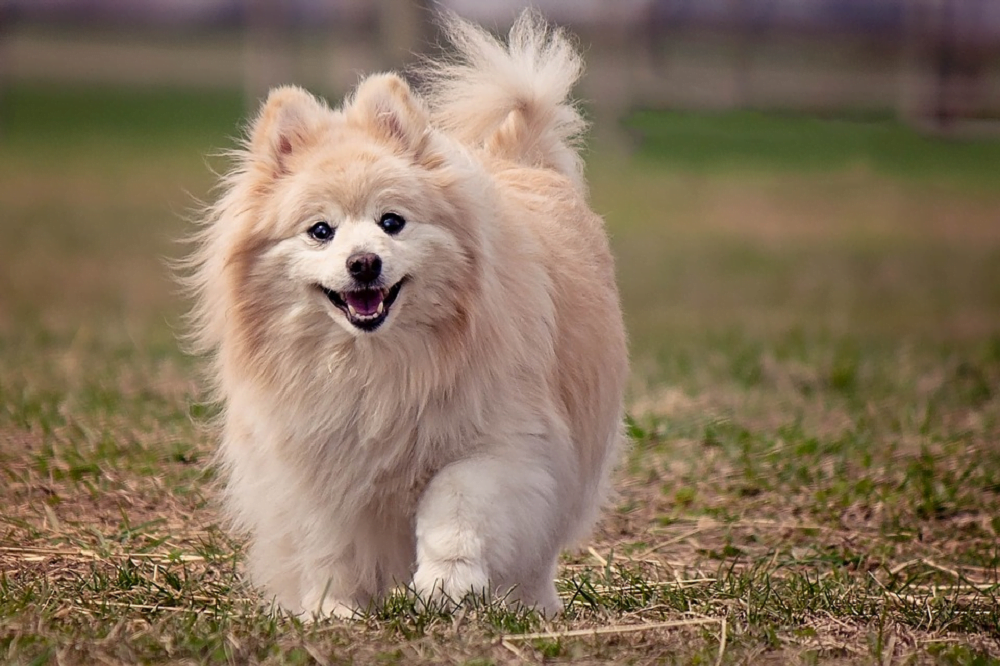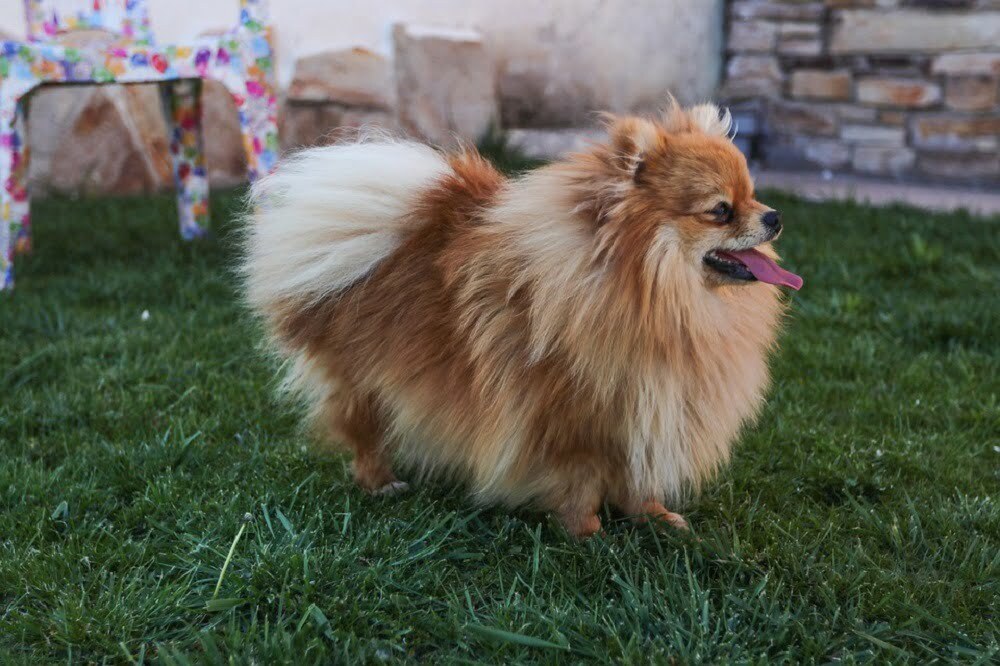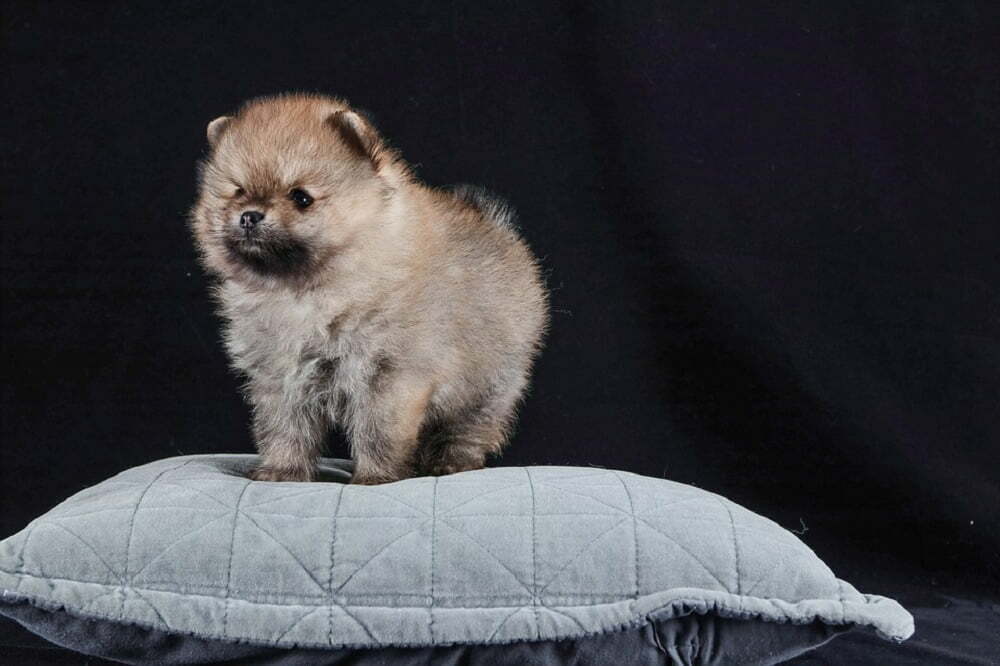Confident, curious and energetic, the Pomeranian might be a small breed, but boy do they have big personalities! Often referred to as just Poms, these gorgeous little fluff balls hail from the German Spitz breed, so named after the region of Pomerania they come from.

Key Facts
Average Lifespan
According to the American Kennel Club, the average Pomeranian will live between 12 and 16 years, but of course any dog’s life expectancy will primarily depend on their quality of life, breeding and other factors outside of your control. Don’t fret, though: provided your Pom is well kept, exercised properly and eats healthily, they should live a long, healthy life.
Minimum Exercise (per day)
Though surprisingly energetic for such a small creature, Pomeranians require only around thirty minutes of exercise each day. This is usually delivered best in the form of a few walks scattered throughout the day, as well as an opportunity to go for a run in a safe, enclosed area.
Coat Length
Thick and textured, Pomeranian fur starts off short when they are newborns, but will eventually grow to between three or four inches once your Pom reaches adulthood. You’ll find that their hair is shorter on the legs and longer at the chest, with varying lengths all over the body.
Pomeranians are also known for having plumed high, flat tails, as well as their distinctive ruff of neck fur, which is formed from the top coat. As well as this, you will find feathery hair in a fringe on their hind quarters and around their butts – Poms are very textural dogs!
Minimum Cost (per month)
On average, Pomeranians should cost you around $100 a month,
Appearance
Size
Pomeranians are considered a “toy” breed for their especially small size.
This is partially down to the fact that Queen Victoria herself owned a small Pom, so the trait was purposefully bred into lineage as it became so popular to have a pint-sized pup. As a result, the breed’s average size decreased by half during her lifetime! You also have the Teacup Pomeranian dog breed, which is smaller than the regular Pomeranian.
Average Height
On average, Pomeranians stand between around 8 and 14 inches tall at the shoulder blade, making them particularly petite in the world of dogs.
Average Weight
A fully-grown, female Pom will weigh between 2 and 2.5kg, slightly heavier than their male counterparts, who come in at a smaller 1.8 to 2kg on average.
Temperament
Apartment Living?
Pomeranians are ideal for living in apartments or flats! Quite content to follow you around and snuggle up wherever you go, so long as they’ve been walked and played with of course, they only need minimal exercise so a lack of outdoor space is not a hindrance.
Likewise, as they’re only small creatures themselves, they won’t be mad about the size of your apartment, nor will it feel crowded because of a Pom’s presence – you might need some little steps to help them get onto furniture, though!
Good For Novice Owners?
Yes, Pomeranians can make a wonderful first dog for someone or a whole family, provided you’ve got the patience necessary to train one! Being both adorable and easily cared for, they fit in great at home, but you must let them know you are in charge there.
Sensitivity Level
Poms are particularly sensitive pups who tend to whine if they are stressed or upset, and they can be temperamental or act out if they are not trained properly. Provided you are strict and train well, there’s no reason why you should find this becomes a regular habit.
Tolerate Being Alone?
As a general rule, yes: once a Pomeranian is approximately a year old, they’ll be okay to hang out by themselves for between six and eight hours, provided they have access to water and somewhere to go to the bathroom.
However, if you notice that your pup is especially clingy or has an attachment or anxiety issue, you can’t leave them alone for that long until you’ve trained them to handle less time apart.
Tolerate Cold Weather?
For the most part, Pomeranians will be fine in the cold: being a European breed with a long double coat means they’re fairly self-sufficient in chillier temperatures. That said, anything less than 32 degrees Fahrenheit and you’ll want to pop on a sweater or winter coat to assist in keeping them warm.
If you’re cold and fully dressed, then your Pom is probably also feeling the chill! Some might push back when it’s time for walkies or even stop in the middle of one if they’re too cold to continue – so always be prepared!
Tolerate Hot Weather?
Although those higher temperatures can be unpleasant and uncomfortable for any breed, potentially posing a risk of heat-related illnesses, Pomeranians are especially susceptible to overheating.
Their coats are thick and fluffy, and because dogs cannot sweat, their only method of cooling down is panting. On a hot day, this is a useless coping mechanism; they can die unexpectedly very suddenly of heat stroke.
It’s your responsibility to keep them cool and ensure you’re offering plenty of water and access to a cool breeze or other methods of temperature regulation where possible. Otherwise, the consequences could be fatal.
Affectionate With Family?
Oh, absolutely! Pomeranians are some of the cutest, cuddliest pooches around and will absolutely adore spending all of their time snuggled up wherever you and the rest of your family are. As they have a longer than average lifespan, they’ll live to see you all go through many trials and tribulations, becoming a firm foundation of your home and providing love and support whenever you need them.
Kid-Friendly?
In general, yes, Pomeranians are friendly pooches who like to play and cuddle, so they get along well with kids who want to give them attention. However, it is imperative the child in question knows that a Pom is not, in spite of their small size, a toy, and cannot be roughhoused with the same way you might a bigger breed.
Therefore, when it comes to toddlers and kids who aren’t old enough to understand how to play and cuddle gently, you should take precautions to ensure they don’t have a chance to aggravate your Pom or accidentally cause them harm.
Dog-Friendly?
Whilst Pomeranians can generally get along well with other dogs, it is in your best interest not to mix them with especially large breeds unless you know you’ll always be around to supervise their playtime, as it’s possible they could get hurt entirely by accident.
A well-socialized Pom should be happy sharing their home with most dogs, but given their toy stature, they are generally best suited to other teeny breeds, like toy Poodles, a Maltese, a Westie or a Shih Tzu for instance.
Friendly Towards Strangers?
Though every breed has outliers who display behavior away from the norm, Pomeranians generally tend to be pretty cautious of strangers. They won’t necessarily start attacking unless they feel threatened, so you must prioritize socialization (with humans and fellow canines!) to ensure they behave well and form secure attachments with pups and people alike.
Failure to encourage these positive connections may well result in their inherent caution evolving to a general suspicion of strangers and negative behavior around them, like barking, crying, whining and possibly even lashing out, depending on how bad things get.
Health and Grooming
 Shedding
Shedding
With such a beautiful and fluffy coat, it would be shocking if Pomeranians didn’t shed! Although they aren’t the breed with the worst habit for leaving hair everywhere, they’re certainly quite high up the list, being one of the hairiest toy breeds around. Regular vacuuming and good grooming habits should be enough to prevent a problem, in any case!
Drooling
Thankfully, Poms are renowned for being a breed that don’t drool very much! Though all pups, like humans, will produce saliva and might find themselves drooling a little on rare occasions, you shouldn’t find that it is a chronic issue in day-to-day life. That’s one less thing you’ll have to clean off yourself and the furniture!
Grooming
Keeping this majestic coat looking so beautiful is no mean feat: grooming is something you’ll have to put into your daily routine with a Pomeranian, though it’s a great opportunity for you to bond with each other and – provided they’re not sensitive about it – can actually be pretty therapeutic for you, too.
Using a firm bristle or wire pin brush, you want to gently groom out from the skin rather than along the body – this will help keep them free of tangles and looking radiantly cloudlike all day long. Though every day is best, you should set aside grooming time at least twice a week to ensure they don’t develop knots.
It’s not difficult, so long as you keep it up!
General Health
On average, the Pomeranian is a healthy breed that lives to a ripe old age. That being said, there are a couple of potential health problems they might experience for a few reasons, which are outlined below.
Common Health Problems
Pomeranians are more likely to experience to following problems as a breed:
- Luxating patella: whether through malformation or trauma, the patellar groove in a Pom’s knee is too shallow to properly sit in a secure position, which can cause it to “luxate” or fall out of place sideways until the whole leg locks and pulls the foot off the ground.
- Black skin disease: a combination of alopecia and hyperpigmentation, this disease can also be referred to as coat funk, woolly coat or severe hair loss syndrome and tends to impact males more than it does females.
- Cryptorchidism: Male Pomeranians are also susceptible to this illness, wherein one or both of the testicles has not descended into the scrotum, which requires surgery to remove and correct the issue.
Merle colored Pomeranians are, because of their coloring, also more likely to develop mild to severe deafness, blindness and other issues with their eyes, nose and throat.
Potential For Weight Gain
As they are such a small and loving breed, it is very easy for owners to feed them too much, resulting in obesity, which is a significant issue for Pomeranians. Having a huge strain on their small bodies, it can lead to or worsen existing joint problems, as well as cause digestive or metabolic disorders and increase their risk of heart disease.
It is important, therefore, to ignore that gorgeous teddy bear face when they whine for more treats, and instead show your affections in a different, less unhealthy way!
Trainability
Easy To Train?
For the most part, Poms tend to be fairly easy to train, as long as you’re able to retain authority. That being said, they do have a stubborn streak that requires more patience than the average small breed and an independence that can also cause training to be a little bit trickier.
Likewise, because they are a toy breed, they have a smaller bladder, which can make potty training more difficult, as they have to pee more often! Little control over their bladder means accidents are more likely, so it’s important to be vigilant and offer plenty of opportunities to eliminate waste.
The easiest way to train a Pomeranian is by using positive reinforcement, simplistic commands and ensuring you regularly practise the skills you are developing to make sure they are cemented.
Intelligence
Ranking quite highly amongst the most intelligent dog breeds, Pomeranians are fairly clever and extroverted creatures who love to explore, learn and play. You’ll find that, with the right resources, reinforcement and reward, training them is simple, and having fun is easy!
Potential To Bite?
Any dog will bite when they feel threatened, or even during playtime to show dominance – it is an inherent trait that affects all breeds. However, if not properly socialized with other animals and people equally, their natural instinct to be wary of strangers will be encouraged and the likelihood of them biting may increase.
Tendency To Bark Or Howl?
Like most small and toy breeds, Pomeranians are very easily encouraged into whining, barking and howling without the proper training and a stable routine. Dogs howl or bark when they are distressed or upset, right? It’s important to teach them that outside noises, strangers and other potential threats and fears are not something they should react to.
History

Believed to be a descendant of the German Spitz, Pomeranians are said to have gained their name by being associated with Pomerania, an area that covers parts of Poland and Germany across the Baltic Sea, which is credited with breeding the very first Poms. Unfortunately, documentation of their breed was not created until they were introduced to the United Kingdom.
Way back in 1767, British queen Charlotte, consort of King George the Third, brought two Pomeranians – Phoebe and Mercury – to England with her. They can be seen in Thomas Gainsboroguh’s 1785 painting Portrait of Mr and Mrs William Hallett, documenting that Poms were once upon a time a considerably larger breed!
As explained earlier, Queen Victoria – Charlotte’s granddaughter – inherited the enthusiasm for this beloved breed, creating a large breeding kennel from which came many beautiful Pomeranians. A well-known favorite of hers was Windsor’s Marco, a red sable who was exhibited in 1891, causing the smaller Poms to very quickly ramp up in popularity.
Queen Victoria made it her mission to promote and improve the breed with dogs taken from all across Europe by importing many Poms of different colors to bring to her breeding program.
The very first Pomeranian breed club was established in England in 1891, with the first breed standard being drafted and published soon after. The very first member of the breed was registered to the American Kennel Club in 1898 and officially recognized in the United States by 1900.
Costs
On average, it’s going to cost you between $500 and $5,000 to get a Pomeranian puppy, though the most common prices are typically set between $1000 and $3000, with the rarer black colors costing significantly more.
Of course, purebred Poms are always going to be more expensive than a mixed breed; likewise, designer mixes like Pomskies (a combination of Pomeranian and Husky) or Pomchis (bred by mixing Pomeranians and Chihuahuas) are likely to be more expensive than other less popular combinations.
Puppies born to award-winning show Pomeranians are likely to skyrocket in price, costing as much as $12,000 depending on the accolades of their parents.
As with all breeds,the easiest and most affordable way to get a Pomeranian is to rescue one! Many kennels have a reserve list for popular breeds, so do some research and register with those.
Fun Facts
- Of the three dogs who survived the Titanic’s sinking, two were Pomeranians: one was named by Lady and owned by a Miss Margaret Hays, rescued in lifeboat seven; the other belonged to Elizabeth Barret Rothschild, who was also rescued by lifeboat six.
